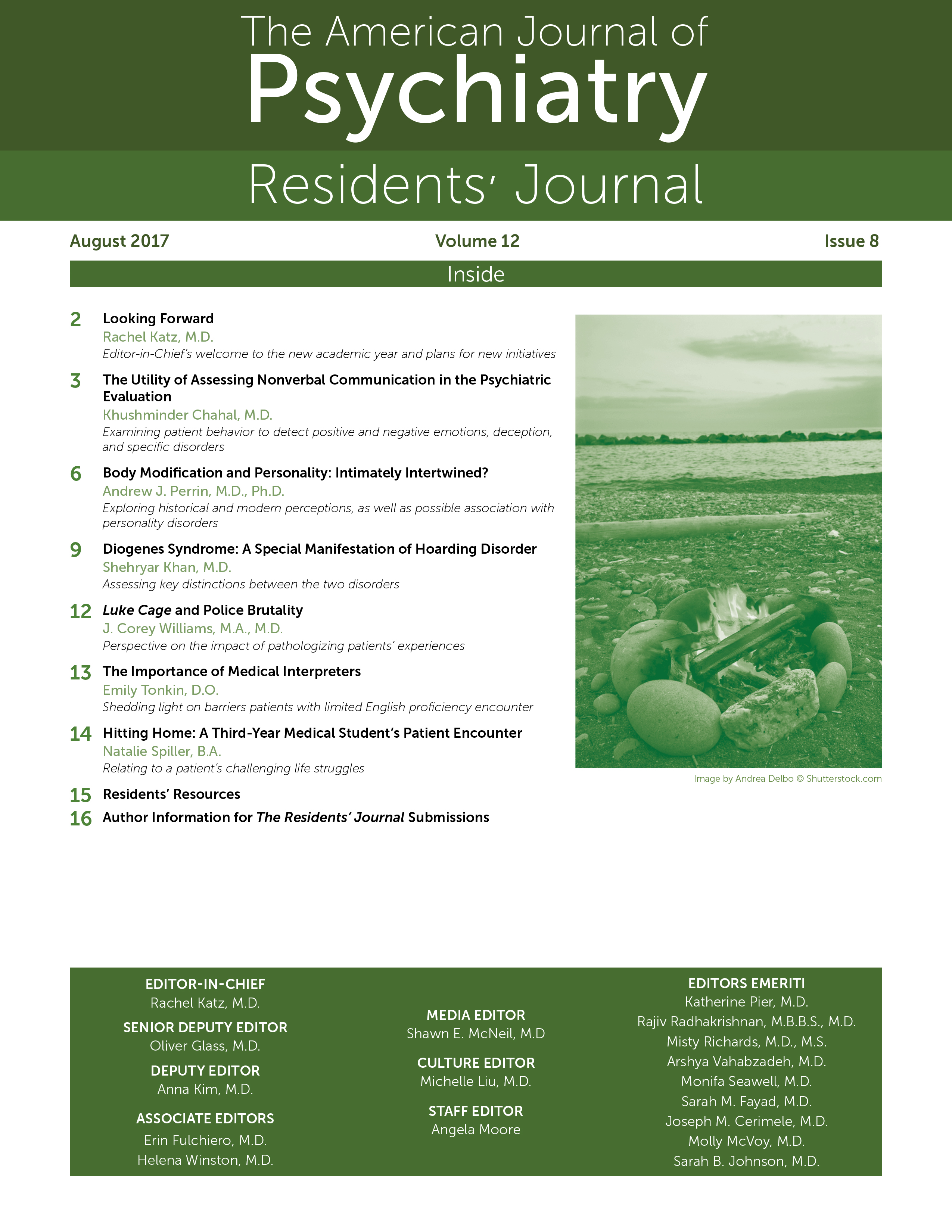Diogenes Syndrome: A Special Manifestation of Hoarding Disorder
The onset of extreme self-neglect in elderly individuals where there is a temporal relationship to the news of a life-threatening illness has been reported in literature and referred to as Diogenes syndrome, named after the ancient Greek philosopher who lived in a barrel in the 4th-century BCE. A depiction of Diogenes, by French painter Jean-Leon Gerome (1), is shown in Figure 1. Macmillan and Shaw first described the syndrome in 1966 (2). The term Diogenes syndrome was later coined by Clark et al. in 1975 (3). The syndrome was named after Diogenes, as the ancient Greek philosopher showed “lack of shame” and “contempt for social organization” (3). However, many authors have argued that there was not much discussion of why the eponym is appropriate and have argued that the term is a misnomer (4–6). There has been a proposal for use of the term “severe domestic squalor” as a better descriptor of this syndrome (4). In the present case report, Diogenes syndrome and severe domestic squalor are used interchangeably to describe the same psychopathological phenomenon. Both these descriptors refer to a person’s home becoming so unclean, unhygienic, and repulsive that individuals of similar culture and background would consider extensive clearing and cleaning to be essential (4, 5). The present case report is of a patient with sudden-onset hoarding of garbage, spoiled food, and excreta in his house after a life-threatening diagnosis.

FIGURE 1. Jean-Leon Gerome’s Painting Depicting the Greek Philosopher Diogenes (404–323 BC)a
a Permission to publish this image in the Residents’ Journal was obtained from and granted by The Walters Art Museum, Baltimore.
Case
“Mr. F” is a 78-year-old widowed, Caucasian man with a past medical history of hypertension and coronary artery disease who was diagnosed with carcinoma of the paranasal sinus with leptomingeal carcinomatosis 6 weeks prior. He was brought into the hospital for concerns with regard to worsening dysphagia, fatigue, and serosanguinous drainage from his nose. He had been started on carboplatin chemotherapy infusion 1 month prior. He was admitted to the oncology floor for evaluation and management of his symptoms. While a history was being collected, Mr. F’s son shared his concerns with the primary team about his father’s hoarding garbage, spoiled food, and excreta at home since the cancer diagnosis. Mr. F lived alone, and there had been accumulation of “waste” congesting and cluttering the living area. Social work was consulted to determine whether there were any safety concerns if the patient was discharged back home, and a psychiatric consultation was requested for evaluation for a psychiatric disorder and assessment of cognitive functioning.
The patient was seen and evaluated by the psychiatric consultation-liaison team. He did not meet DSM-5 criteria, currently or in the past, for major depressive disorder, adjustment disorder, bipolar disorder, generalized anxiety disorder, obsessive-compulsive disorder, or posttraumatic stress disorder (7). He did not have symptoms of psychosis, and he did not meet criteria for hoarding disorder, as there was no sentimental attachment to possessions in the house nor a perceived need to necessarily keep “waste” at home. Moreover, the patient lacked insight into his situation at home and did not report distress. The impairment was apparent only to his family members who were concerned about his safety at home. He had some demoralization related to his cancer diagnoses but did not have hopelessness and wanted to take it “one day at a time.”
The patient did not have a history of current or prior excessive alcohol use or any recreational drug use. However, he had a 50-pack per year smoking history and did meet criteria for nicotine use disorder, moderate, in a controlled environment. Pertinent mental status examination findings included the patient being pleasant, cooperative, and appropriately light-hearted and humorous during the assessment. His mood was euthymic, with intensity, range, and reactivity of affect within normal limits. His thought process was goal-directed. His cognitive testing was completely intact for orientation, executive function, attention, memory, abstract reasoning, naming, and language.
The patient’s social history was pertinent for a successful career in the automotive industry for over three decades, and he had started a small family business after his retirement. Upon collateral from his family, it was verified that his “hoarding” behavior, as was referred by the family, had started just 1 month prior, per the family’s best estimate, and this was after his cancer diagnosis. Prior to this, there had been no concerns regarding similar behavior.
Discussion
The annual incidence of Diogenes syndrome has been estimated to be around 5 per 10,000 in individuals aged 60 and older and living alone (8). There has been mixed evidence in terms of prevalence of comorbid disorders. A study of 30 individuals with Diogenes syndrome found that 50% had no comorbid psychiatric disorder (4). Another study of 72 individuals with Diogenes syndrome found that isolation, alcoholism, and psychotic disorder coexisted (3). Although these two studies have the largest sample sizes studied for this disorder, a major limitation of these studies is that both were published before 1975, bringing into question diagnostic validity and reliability. Over the years, several individual reports have been published, highlighting the continued identification of this syndrome.
Extreme self-neglect in elderly individuals, with nutritional deficiencies, was described in patients who had a high intelligence quotient, often with successful careers in the past, who started to live in squalid surroundings and became neglectful of their personal hygiene and nutrition at the onset of life-threatening illness (9). There is a reported case of a woman with “onset of neglect” after a breast lump was identified, and this period of time was associated with sudden-onset of poor personal and domestic hygiene (10). It is interesting to note that the patient had resumption of baseline personal and domestic hygiene after successful excision of the lump (10). A French review on Diogenes syndrome also commented on the abnormal hoarding of random items in the home to be associated with neglect of one’s domestic cleanliness (11). The individuals examined had been noted to have struggles with precarity, which can explain an underlying challenge for asking for help (6). Irvine and Nwachukwu described the main characteristics of Diogenes syndrome as being “domestic squalor,” “self-neglect,” and “lack of shame” regarding domestic hoarding (11). An Australian review of Diogenes syndrome also described the hoarding pattern to consist of rotting food, excrement, or odors likely causing feelings of revulsions among family and visitors, similar to the pattern in the patient in the present case report (5).
Increased mortality rate has been reported in these patients, with a 46% 5-year death rate secondary to the physical complications of their underlying medical condition (12). In another study, it was reported that these individuals have a 5.8-times greater 1-year mortality rate than age-matched individuals (13). Dehydration, malnutrition, infections, falls, and injuries are common presentations and likely causes for increased mortality (4).
Out of all the diagnostic categories, Diogenes syndrome is closely related to, but distinct from, hoarding disorder (14) (see Table 1). Key distinctions of hoarding disorder from Diogenes syndrome are that in the latter, there is abnormal cluttering of invaluable possessions without any sentimental attachment, with poor insight, and with no distress regarding this cluttering behavior.
| DSM-5 Diagnostic Criteria (A–D) for Hoarding Disordera | Proposed Diagnostic Criteria for Diogenes Syndrome (Severe Domestic Squalor) |
|---|---|
| Persistent difficulty discarding or parting with possessions, regardless of their actual value. | Excessive abnormal cluttering of invaluable possessions resulting secondary to a transient life circumstance. |
| The difficulty is due to a perceived need to save the items and to distress associated with discarding them. | There is no sentimental attachment to the possessions. |
| The difficulty discarding possessions results in the accumulation of possessions that congest and clutter active living areas and substantially compromises their intended use. | (same as hoarding disorder) |
| The hoarding causes clinically significant distress or impairment in social, occupational, or other important areas of functioning (including maintaining a safe environment for self and others). | There is poor insight; the individual may not report distress, and the impairment may be apparent only to those around the individual. |
TABLE 1. Distinguishing Hoarding Disorder From Severe Domestic Squalor (Diogenes Syndrome)
In conclusion, Diogenes syndrome, also described as severe domestic squalor in the literature, has been identified in several case reports, and further investigation into this psychopathological process will be important in considering it as a distinct diagnostic entity to be considered for future editions of the DSM.
Key Points/Clinical Pearls
Diogenes syndrome is described as behavioral onset of excessive abnormal cluttering of invaluable possessions secondary to a transient life circumstance.
The individual with the disorder has poor insight, and usually visitors and family members are the ones to first notice the cluttering behavior.
The disorder is rare but has been associated with high mortality rates.
The disorder represents a different entity from hoarding disorder and needs to be further studied to be classified as a separate diagnosis.
1.
2. : Senile breakdown in standards of personal and environmental cleanliness. Br Med J 1966; 2:1032–1037 Crossref, Google Scholar
3. : Diogenes syndrome: A clinical study of gross neglect in old age. Lancet 1975; 1(7903):366–368 Crossref, Google Scholar
4. : Severe Domestic Squalor. Cambridge, United Kingdom, Cambridge University Press, 2012 Crossref, Google Scholar
5. : Refining the diagnostic boundaries of compulsive hoarding: a critical review. Clin Psychol Rev 2010; 30(4):371–386 Crossref, Google Scholar
6. : Psychosocial approach to Diogenes syndrome. Soins Psychiatr 2015; (298):17–20 Crossref, Google Scholar
7.
8. : The need to consider mood disorders, and especially chronic mania, in cases of Diogenes syndrome (squalor syndrome). Int Psychogeriatr 2011; 23:505–507 Crossref, Google Scholar
9. : Life-threatening folic acid deficiency: Diogenes syndrome in a young woman? Am J Med 2015; 128(8):e7–8 Crossref, Google Scholar
10. : Unmasking Diogenes syndrome. Indian J Dermatol 2015; 60(3):287–289 Google Scholar
11. : Recognizing Diogenes syndrome: A case report. BMC Res Notes 2014; 7:276 Crossref, Google Scholar
12. : Diogenes syndrome: when self-neglect is nearly life threatening. Clinic Geriatr 2005; 13(8):10–13 Google Scholar
13. : Elder self-neglect and abuse and mortality risk in a community-dwelling population. JAMA 2009; 302:517–526 Crossref, Google Scholar
14. : On hoarding and squalor: a few considerations for DSM-5. Depress Anxiety 2012; 29(5):417–424 Crossref, Google Scholar



